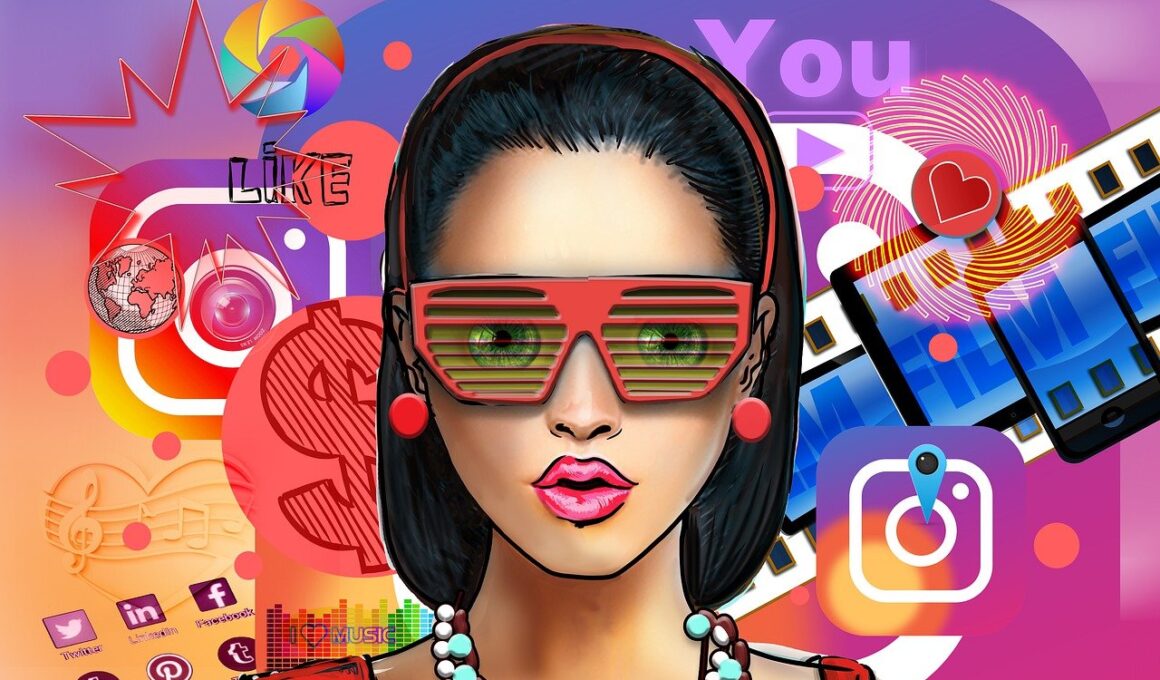The Role of Influencer Collaborations in Mobile Social Media Advertising
In the ever-evolving landscape of digital marketing, influencer collaborations are proving to be pivotal especially within mobile social media advertising. Brands are recognizing that connecting with consumers through authentic voices can yield more significant results than traditional advertising methods. Social media influencers carry substantial engagement and trust with their audience, making them an essential asset for brands aiming to increase visibility and credibility in competitive markets. Collaborations often encompass various formats such as sponsored posts, product endorsements, and collaborative campaigns, allowing companies to reach target demographics effectively. These partnerships strategically leverage the influencer’s follower base, creating targeted messaging designed to resonate with specific audience segments. Successful campaigns thrive on genuine relationships between brands and influencers, facilitating deeper customer connections and brand loyalty. Furthermore, influencers are adept at producing creative content that stands out in crowded social media feeds. As consumers become more selective about the content they interact with, aligning with influencers who reflect brand values becomes paramount for authentic engagement. This dynamic collaboration continues to shape how brands engage and communicate with their audience in the mobile social media space.
The appeal of influencer marketing lies in the influencer’s ability to create authentic narratives around a brand’s product or service. By showcasing products in a relatable context, influencers can humanize brands and tap into the emotional triggers that drive consumer decisions. Statistics show that mobile social media users are more likely to trust recommendations from influencers they follow compared to typical advertisements. This trust fosters not only brand awareness but also encourages action, including app downloads and product purchases. Today’s consumers are looking for connections over promotions, and influencer-generated content provides that bridge. By choosing micro-influencers with niche audiences, brands can achieve high levels of engagement at a lower cost. Those smaller influencers often boast stronger relationships with their audience, leading to more impactful collaborations than those with macro-influencers. Focusing on this strategy can drive efficiencies in both reach and budget allocation. Moreover, the capacity for real-time feedback on campaigns is enhanced through mobile social media channels, allowing brands to adapt strategies swiftly and effectively. Ultimately, effective influencer collaborations translate excitement and passion into actionable results, aligning with users’ growing preference for personalized marketing.
Another significant aspect of influencer collaborations in mobile social media is the ability to track and measure effectiveness. Brands can access real-time data analytics to assess campaign performance, making it easier to understand consumer engagement and behavior. Utilizing analytics tools, organizations can gauge metrics like reach, impressions, click-through rates, and conversions. Such data is crucial for adjusting ongoing campaigns and optimizing future initiatives. Incorporating UTM parameters into shared links allows marketers to attribute specific sales to their influencer partners meticulously. By tracking the direct impact of influencer collaborations, brands can refine their approaches to achieve even better results. This continuous improvement cycle is essential for mobile advertising where user trends change rapidly. Moreover, utilizing insights from influencer interactions can inform broader marketing strategies, helping brands anticipate market shifts and adjust their outreach accordingly. Engaging analytics not only measures success but enhances relationships with influencers, leading to more fruitful long-term partnerships. Over time, data-driven decisions enable brands to strengthen their positioning within their competitive landscape and elevate their marketing game through savvy influencer collaborations.
Best Practices for Collaborating with Influencers
Success in mobile social media influencer collaborations requires adhering to best practices that ensure genuine connections. First and foremost, brands should conduct thorough research to select influencers whose values align with their own. These partnerships should feel organic, providing audiences with authentic experiences rather than overt advertisements. Establishing clear communication and expectations upfront can prevent misunderstandings and enhance collaboration effectiveness. Additionally, brands should offer creative freedom to influencers, allowing them to present products in a way that resonates with their audience. This strategy enhances the relatability of the content. Incorporating incentives such as affiliate links or exclusive promo codes can also motivate influencers to dedicate more effort towards creating compelling content. Recognizing and compensating influencers for their work shows respect for their craft. Furthermore, brands should monitor engagement and interactions around influencer content to identify what resonates best with audiences. Such real-time insights can inform future campaign strategies and influencer selections. Collaboration also entails keeping an eye on market trends and adjusting strategies as needed. By following these practices, brands will maximize their influence and strengthen their presence in mobile social media advertising.
Engaging influencers effectively goes beyond mere transactions; it involves building long-lasting partnerships that can evolve over time. Consistency in collaboration can lead to deeper brand loyalty and recognition. When influencers frequently promote a brand, audiences begin to perceive the brand as a natural extension of the influencer’s lifestyle. This organic integration provides a persuasive tool for potential customers who are more likely to trust the influencer’s opinions as they seem genuine. Developing a collaborative long-term strategy enables brands to create narratives that progress over time, keeping the audience interested and engaged. As influencers share their experiences with products in various contexts, it opens doors for storytelling—a powerful marketing aspect that resonates with users. Furthermore, ongoing partnerships can lead to more innovative campaigns, pushing the boundaries of creative collaboration. As both parties understand each other better, they can experiment with new ideas that captivate viewers’ attention. Brands should invest in nurturing these relationships, allowing them to derive maximum value from influencer collaborations while allowing the influencers to maintain their authenticity. This mutual benefit is crucial in a landscape saturated with advertising noise.
It is essential to adhere to guidelines and regulations when partnering with influencers. Both brands and influencers must ensure transparency, especially when it comes to disclosing partnerships with clear indications of sponsored content. The Federal Trade Commission (FTC) has stipulations regarding endorsements, which are crucial to maintaining trust with audiences. Influencers need to disclose if they are being compensated or gifted a product during their promotions. Non-compliance can lead to damaging reputational consequences for both parties involved. Additionally, developing guidelines covering content styles and frequency of posts helps ensure that both brand and influencer are on the same page. Having a well-defined agreement allows both parties to be aware of their obligations, delivering a smoother collaboration experience. Broader compliance includes respecting platform-specific guidelines as well. Mobile social media platforms often have unique features and algorithms that dictate how content is displayed. By understanding these nuances and adapting strategies accordingly, brands and influencers can enhance the visibility of their collaborative efforts. Ethical engagement fosters positive relationships, reinforcing consumer trust which is imperative for sustained success in advertising.
The Future of Influencer Collaborations
The landscape of influencer collaborations in mobile social media is continuously evolving, adapting to consumer needs and technological advancements. As augmented reality (AR) and virtual reality (VR) technology progresses, brands will have opportunities to create immersive experiences through influencer partnerships. These innovative strategies will deepen user engagement by offering interactive content that connects audiences with brands on a personal level. Additionally, the rise of artificial intelligence in content creation may open doors for further collaboration types, allowing influencers to automate certain tedious tasks while focusing on creative elements. Furthermore, as social media platforms evolve, incorporating newer features like live-streaming and shopping directly within apps, influencer roles will expand to include more diversified content formats. Sustainability and ethical considerations will also play a crucial role, as consumers demand accountability and transparency from brands and their partnerships with influencers. The future will hinge upon aligning with influencers who advocate for positive social impact, leverage responsible branding practices, and utilize their platforms to foster community engagement. Such collaborative efforts will not only meet consumer expectations but revolutionize how branding and advertising are conducted across mobile social media channels.
Lastly, analyzing emerging trends will help brands refine their strategies in mobile social media influencer collaborations. Tracking user preferences, behavior patterns, and engagement metrics informs better targeting and personalized messaging efforts. As audiences continue to evolve, staying informed about shifting interests and rapidly changing environments is imperative. It is crucial for brands to maintain flexibility while employing influencers adept at adapting to changes within their niches. By opting for diverse and inclusive representation among influencers, brands can resonate with a broader audience, strengthening outreach. Enhanced authenticity through varied perspectives will enrich campaign messaging. Fostering an innovative mindset that encourages experimentation with new channels and engagement strategies will keep brands competitive. Additionally, leveraging data analytics will empower brands to make informed decisions, ensuring optimized results from collaborations. The world of influencer marketing is not static; it demands a proactive approach to keep pace with trends. In an increasingly digitized environment, the key to success lies in fostering human connections at every marketing touchpoint. Ultimately, brands that embrace these evolutions and collaborative opportunities will position themselves favorably within mobile social media advertising, creating lasting impressions with their audiences.


